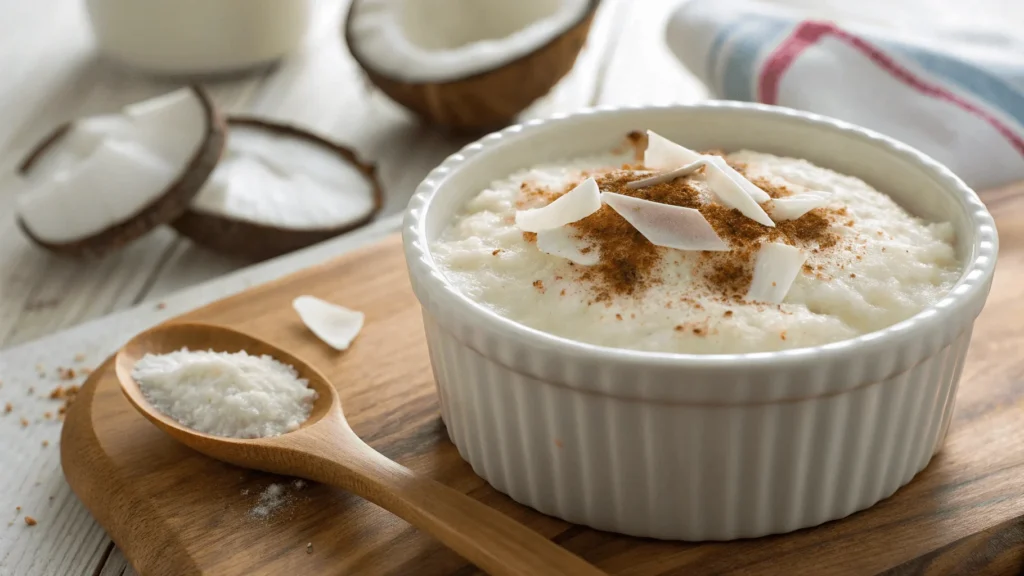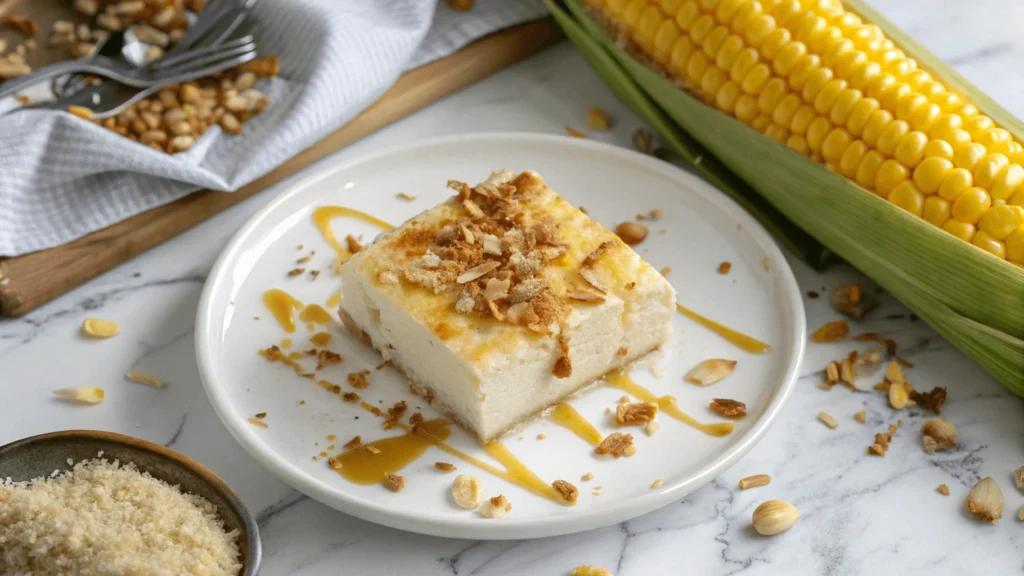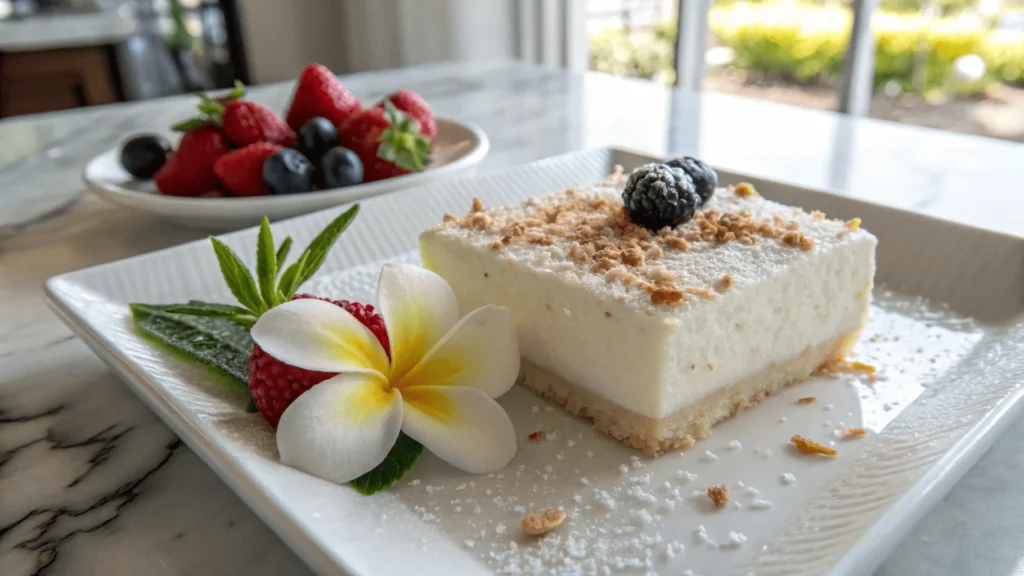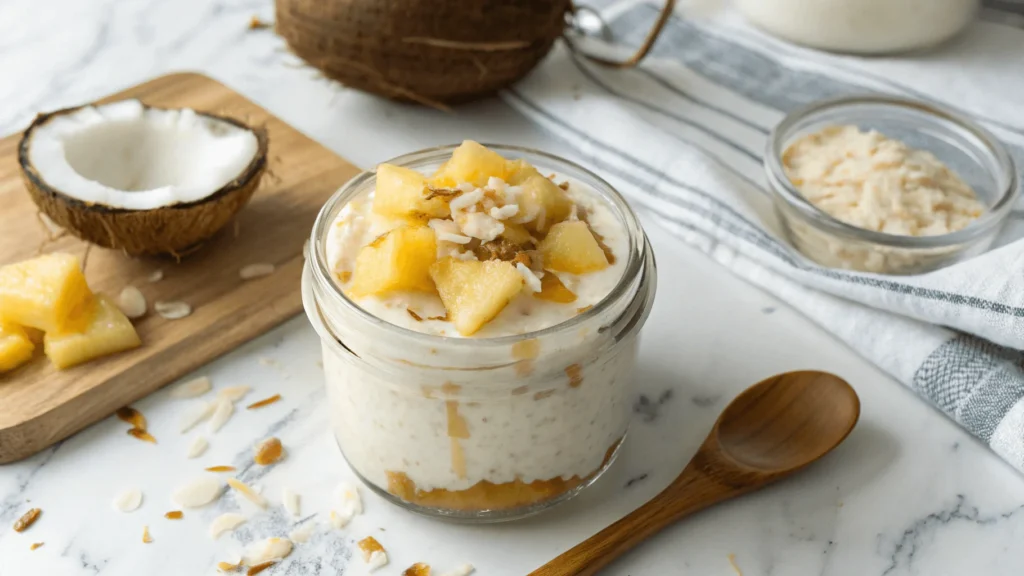Coconut pudding is a beloved dessert in many cultures, offering a creamy and rich texture that’s hard to resist. But what exactly is coconut pudding made of? In this article, we’ll take you on a delightful journey through the basic ingredients, regional variations, nutritional details, and even a simple recipe to try at home. Whether you’re already a fan of coconut-based treats or you’re curious to learn more, this guide will give you all the information you need about coconut pudding and its versatility in the world of desserts.
Introduction to Coconut Pudding

Coconut pudding is a smooth, creamy dessert made with coconut milk or coconut cream as the primary ingredient. Often, it’s sweetened with sugar or other natural sweeteners, and its texture is thickened with ingredients like cornstarch or agar-agar. But if you’re wondering, what is coconut pudding made of, it’s more than just these basic ingredients! This dessert is known for its tropical flair, and it holds a special place in various cuisines worldwide.
What Is Coconut Pudding?
At its core, coconut pudding is a dessert that combines coconut milk, sweeteners, and thickening agents into a silky-smooth treat. This pudding comes in several variations, depending on the region and available ingredients. The pudding’s base is often coconut milk, which gives it that signature coconut flavor, while the thickening agents help create a custard-like consistency. To dive deeper into its unique ingredients, check out this detailed guide about coconut pudding.
Cultural Significance and Popularity
Coconut pudding has long been a favorite in many parts of the world. From the Philippines’ maja blanca to Puerto Rico’s tembleque, coconut pudding is celebrated across the globe. It’s also a popular dish in Hawaii, often served as haupia, and in many Caribbean islands. The dessert’s rich flavor and versatility make it perfect for special occasions, as well as a delightful everyday treat.
Common Ingredients in Coconut Pudding
When you’re wondering, what is coconut pudding made of, the answer often revolves around a few essential ingredients that create its signature creamy texture and tropical taste. Let’s take a look at the basic components that make this dessert irresistible.
Coconut Milk and Cream
Coconut milk and coconut cream are the stars of coconut pudding. These two ingredients are derived from the flesh of coconuts, giving the pudding its distinctive flavor. Coconut milk is thinner and lighter, while coconut cream is thicker and richer. In some recipes, the two are used together to balance flavor and texture, resulting in a pudding that’s smooth and velvety.
The coconut milk provides a mild coconut flavor, while coconut cream intensifies the richness, adding depth to the overall taste. If you’re thinking about making this dessert at home, these are the key ingredients you can’t skip!
Sweeteners
Next, coconut pudding wouldn’t be as enjoyable without the right sweeteners. Most recipes call for sugar, but alternatives like palm sugar, maple syrup, or even stevia can be used depending on dietary preferences. The choice of sweetener can change the flavor profile slightly, so feel free to experiment with different options until you find your perfect match. These sweeteners work wonderfully with the coconut flavor and bring the pudding to the right level of sweetness.
Thickening Agents
To achieve that perfectly smooth and custard-like consistency, thickening agents are essential. Cornstarch is the most common choice, but you might also find agar-agar or gelatin being used in some recipes. These ingredients help the coconut milk and cream set into a pudding-like texture. Some recipes even use a combination of both cornstarch and agar-agar for an extra firm consistency.
Flavor Enhancers
Finally, flavor enhancers like vanilla extract or a pinch of salt are often added to balance out the sweetness. A touch of vanilla can help highlight the coconut’s natural flavor, making the pudding even more aromatic and enjoyable.
Regional Variations of Coconut Pudding
Coconut pudding is a global dessert with many regional variations. So, if you’re asking, what is coconut pudding made of in different parts of the world, the ingredients may be quite similar, but the preparations and flavors often vary. Let’s explore some of the unique takes on coconut pudding from around the world. If you’d like to explore more, don’t miss our article on Delicious Coconut Milk Pudding: How To Thicken It Right.
Maja Blanca (Philippines)

In the Philippines, one of the most popular versions of coconut pudding is maja blanca. This creamy dessert combines coconut milk, corn kernels, and rice flour, creating a smooth, custard-like texture. People often serve maja blanca with a topping of toasted coconut flakes or caramelized sugar, adding a delightful crunch to the soft pudding. In some versions, cooks use sweetened condensed milk to enhance the sweetness.
People typically enjoy this variation during holidays and family gatherings, especially during Christmas and other special occasions. It’s a dessert that blends the richness of coconut with the comforting flavor of corn and rice, making it a truly unique treat.
Tembleque (Puerto Rico)
Moving on to Puerto Rico, the island’s version of coconut pudding is known as tembleque. It features a simple yet flavorful combination of coconut milk, cornstarch, sugar, and a touch of cinnamon. Cooks thicken the pudding with cornstarch and set it in molds, then top it with cinnamon and sometimes a sprinkle of nutmeg. People typically serve tembleque chilled, making it a perfect dessert for warm days.
What sets this variation apart is the use of spices, which add a warm, aromatic quality to the pudding. The coconut flavor is still the star, but the cinnamon gives it a cozy touch, making it a comforting dessert.
Haupia (Hawaii)

Haupia, a beloved Hawaiian dessert, is a creamy, gelatinous treat made primarily from coconut milk, sugar, and cornstarch. It has a smooth, almost jelly-like consistency and typically comes in small squares or in a bowl. In Hawaii, people often feature haupia at luaus and serve it alongside other traditional Hawaiian dishes.
One of the standout features of haupia is its firm texture, which cooks achieve by using cornstarch and coconut cream. Unlike other coconut puddings, haupia has a more set consistency, making it easy to cut into pieces for serving.
Coconut Rice Pudding (Various Regions)
Finally, in many Caribbean and Southeast Asian regions, coconut rice pudding is a popular variation. This pudding combines coconut milk, sugar, and cooked rice to create a creamy and comforting dessert. People often flavor it with cinnamon, nutmeg, or cardamom, and they serve it either warm or cold. The rice adds a delightful texture, and the coconut milk provides a rich, tropical flavor.
This rice pudding typically offers a heartier variation compared to others, providing a satisfying blend of flavors and textures. People often serve it at family meals or during special occasions, where they cherish it as a filling and flavorful dessert.
As you can see, there are many ways to prepare this dessert, depending on the region. No matter where you are in the world, it is sure to bring a taste of tropical delight to your table!
Nutritional Profile of Coconut Pudding
When indulging in coconut pudding, many wonder about the nutritional value of this creamy dessert. If you’re curious about the ingredients in coconut pudding regarding its health aspects, you’ll find that while it remains rich and delicious, it also has some key nutritional features worth noting.
Caloric Content
Coconut pudding, like many creamy desserts, can be high in calories. This is due to the use of coconut milk or cream, sugar, and thickening agents, all of which contribute to its calorie count. On average, a serving of coconut pudding can range from 200 to 400 calories, depending on the recipe and portion size. However, if you’re looking for a lighter version, you can always opt for reduced-fat coconut milk or alternative sweeteners to cut down on the calories.
Macronutrient Breakdown
The macronutrient breakdown of coconut pudding consists mainly of fats and carbohydrates. Coconut milk provides a good amount of fat, mostly saturated fat. While some may worry about the higher fat content, it’s important to note that coconut fat differs from animal fats and contains medium-chain triglycerides (MCTs), which many believe have various health benefits.
The carbohydrates in coconut pudding come primarily from sugar, though using natural sweeteners can offer a healthier alternative. For more Tips, read our article on How to Make Pudding with Coconut Milk: Tips and Recipes.
Health Considerations
Although coconut pudding is rich in flavor, it’s also high in sugar and fat. For those managing their sugar intake, I recommend trying alternatives like stevia or monk fruit as sweeteners.
Additionally, for those with dietary concerns, using dairy-free coconut milk makes the pudding suitable for vegan and lactose-intolerant individuals. Just be sure to enjoy this delicious treat in moderation!
How to Make Coconut Pudding at Home

Making coconut pudding at home is easier than you might think! If you’ve been wondering about the ingredients in coconut pudding and how to create this tropical treat yourself, this section will guide you through the steps and offer tips to perfect your pudding.
Basic Recipe Steps
Here’s a simple coconut pudding recipe to get you started:
- Gather the Ingredients: You’ll need coconut milk, sugar (or an alternative sweetener), cornstarch, and vanilla extract. Some people also add a pinch of salt to enhance the flavors.
- Combine Coconut Milk and Sweeteners: In a medium saucepan, combine the coconut milk and sweetener of your choice. Heat the mixture over medium heat, stirring occasionally to prevent burning.
- Thicken the Mixture: In a small bowl, dissolve the cornstarch in a bit of water, then slowly pour this mixture into the warm coconut milk while continuously stirring. Continue cooking until the pudding thickens to your desired consistency.
- Flavor It: Stir in the vanilla extract, and if desired, a pinch of salt for a subtle balance of flavors.
- Chill and Serve: Once the pudding has thickened, remove it from the heat and let it cool slightly. Pour the pudding into serving bowls or cups and refrigerate for a few hours. Serve chilled, topped with toasted coconut flakes or fresh fruit for added flavor and texture.
Tips for Achieving the Perfect Texture
The key to getting the perfect texture for your coconut pudding lies in the cooking process. Be sure to whisk continuously while heating to avoid lumps. If the pudding is too thick, you can thin it out with a little more coconut milk or water. On the other hand, if it’s too runny, simply cook it for a bit longer to allow the cornstarch to work its magic.
Common Mistakes to Avoid
Keep a couple of things in mind when making coconut pudding: First, ensure you dissolve the cornstarch properly in water before adding it to the coconut milk, or you may end up with lumps.
Second, don’t overcook the pudding, as it can become too firm or rubbery. Lastly, ensure that you allow enough time for the pudding to chill, as it helps achieve that smooth, custard-like texture.
For more delicious recipes, check out our article on making creamy desserts from scratch!
FAQs
Can I Use Coconut Extract Instead of Coconut Milk?
While you can certainly use coconut extract to enhance the coconut flavor, it cannot replace coconut milk. Coconut extract is much more concentrated, so you’d need a very small amount to add flavor. Coconut milk, on the other hand, gives the dessert its creamy texture and rich taste. If you’re looking for a lighter version, you could try using a combination of coconut extract and a non-dairy milk, but for the traditional texture, coconut milk is a must.
Is Coconut Pudding Suitable for Vegans?
Yes! This dessert is naturally dairy-free, making it a great choice for those following a vegan diet. Simply use plant-based sweeteners, like maple syrup or agave, and opt for vegan alternatives to any other non-vegan ingredients (such as gelatin) to keep it fully plant-based. As long as you stick to plant-based ingredients, it is a wonderfully creamy and satisfying vegan treat.
How Long Does Coconut Pudding Last in the Refrigerator?
This dessert can be stored in the refrigerator for up to 3-4 days. Be sure to cover it tightly to prevent it from absorbing any other odors in the fridge. However, it’s best enjoyed fresh for optimal flavor and texture. If you plan to keep it longer, consider freezing it, though the texture may change slightly once thawed.
Can I Add Other Flavors to Coconut Pudding?
Absolutely! This dessert is incredibly versatile, and you can easily add different flavors to make it your own. Some popular options include chocolate, mango, or even a dash of lime for a tropical twist. You can also experiment with different spices, such as cinnamon or nutmeg, to give it a warm and comforting flavor.
Conclusion
Coconut pudding is a rich and satisfying dessert that’s loved around the world for its creamy texture and tropical flavor. Whether you’re asking what this dessert is made of or simply looking for inspiration for your next treat, it offers endless possibilities for variation. From the basic ingredients like coconut milk and sugar to regional variations like maja blanca and haupia, there’s a recipe to suit every palate.
This dessert not only offers a delicious way to indulge, but you can also adapt it to fit various dietary preferences. So whether you choose to enjoy it as a traditional dessert or experiment with new flavors, one thing’s for sure—it will always be a delightful treat. Try making it at home, and don’t forget to get creative with the toppings and flavorings. Enjoy the creamy, comforting world of coconut desserts!





